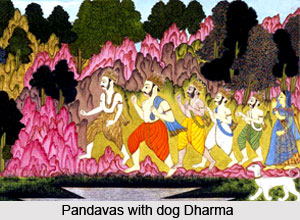 Mahabharata is a legend about the most dramatic figures; various Gods, seers, and Brahmins, including the Pandavas and the Kauravas. The great Indian epic introduces the Pandavas, their valour and their greatness. The Great Indian Epic has gained immense prominence to the culture of the Indian subcontinent. The story of Mahabharat concludes with a vivid description of the eventual end of Pandavas.
Mahabharata is a legend about the most dramatic figures; various Gods, seers, and Brahmins, including the Pandavas and the Kauravas. The great Indian epic introduces the Pandavas, their valour and their greatness. The Great Indian Epic has gained immense prominence to the culture of the Indian subcontinent. The story of Mahabharat concludes with a vivid description of the eventual end of Pandavas.
Upon the onset of the Kali yuga and when Krishna left for heavenly abode, the Pandava brothers retired, leaving the throne to their only descendant Parikshita, who was Arjuna`s grandson. After the great battle of Kurukshetra, the Pandavas started ruling the kingdom of Hastinapur. They meanwhile decided to renounce everything and proceed for Pilgrimage. In the Mahabharat an apt description of the five Pandavas living for the Himalayas is found. They went clad only in rags and retired to the Himalaya and climbed towards heaven in their bodily form. A stray dog also accompanied them during their travels. Unfortunately while on the journey, one by one, each Pandava and Draupadi met their end however leaving Yudhishtira and the stray dog.
As each one stumbled, Yudhishtira gave the rest the reason for their fall. Draupadi was partial to Arjuna, whereas Nakula and Sahadeva were proud of their looks, whereas Bhima and Arjuna were proud of their strength and archery skills, respectively. Yudhishtira did not stumble as he was the only virtuous and righteous person. Finally the dog who travelled with Yudhishtira revealed himself to be the god Yama or Yama Dharmaraja. The God took Yudhishtira to the underworld where he found his siblings and wife. Yama explained Yudhishtira about a test which he had succeeded and took him back to heaven. According to Yama it was necessary to expose Yudhishtira to the underworld for the one lie which he had said during his entire life in the battle field of Kurukshetra. The five Pandava brothers thus came face to face with their doom.
Prior to the incident of their retirement to heaven, five brothers and Draupadi once had to face a similar situation where apparently end of Pandavas was revealed. The event demonstrates a situation that killed all the Pandava brothers except Yudhishtira. While drinking water from a lake. The virtuous Pandava was promised by the Yaksha if he would answer each of his questions. Gradually Yudhishtira satisfied the Yaksha and acknowledging his wisdom the Yaksha helped in reviving the dead Pandavas .
After the end of the Pandavas and their final retirement to heaven, Arjuna`s grandson Parikshita when came of age after ruling Hastinapur for quite a long time also faced an eventual end as he was bitten by a snake. Janamejaya, Parikshita`s son was ferocious and decided to perform a snake sacrifice `sarpasttra` in order to destroy the snakes. With an end of Pandavas a curtain was drawn to a significant chapter in Mahabharata.



















